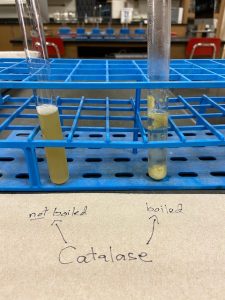Properties of Enzymes (2 weeks of lab) – In Person Labs
Scroll below for In-person Labs
Enzyme Lab Handout (covers 2 weeks of In-Person labs) – Includes areas for filling out your tables and answering questions.
Make sure you have Excel or access to Google Sheets. As an NCSU student, you can download Microsoft Office 365 from NC State’s OIT software site for free!
Read along in your Enzyme Handout as you work with the information in this webpage. Fill in and answer questions accordingly. Your Enzyme Handout will be collected and graded later.
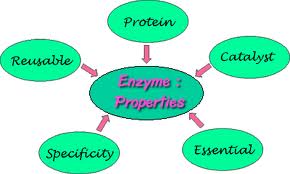
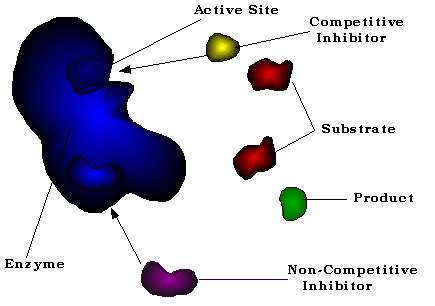
How Cells Work – Enzymes
Chemical Reactions and Activation Energy
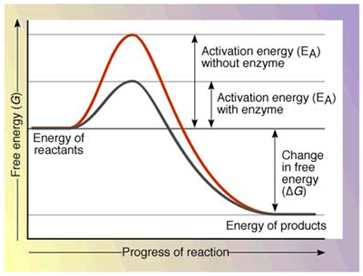
Catalase
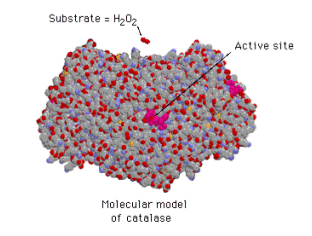
Animation – Enzyme Function and the difference between competitive and non-competitive inhibitors.
Activity 1: Qualitative Study of Catalase
2H2O2 + catalase —-> 2H2O + O2 + catalase
Catalase is prepared by blending a potato in cold water, then filtered by straining the mixture through 4 layers of cheesecloth. The catalase solution is then kept cold on ice. Why would filtering and maintaining a cold temperature be important for the catalase solution?
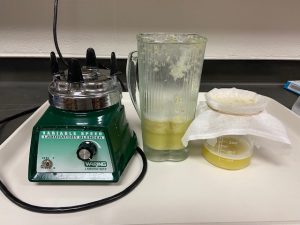
Procedure A Testing the Activity of Catalase
Follow steps 1-3 and complete Table 1 using the results from your 4 prepared test tubes. The picture below shows the appearance of catalase and boiled catalase used Procedure A. What would account for the difference in appearance of the boiled catalase? Where did the “chunks” come from?
Procedure B Testing the Activity of Catalase Under Six Different Environmental Conditions
You will be assigned to work with ONE of the six environmental conditions (Groups) below. Propose a plausible hypothesis for your assigned experiment. The same basic reaction as tube #3 in Procedure A is followed, but treated with an assigned environmental condition. Answer all questions and fill in the Table that corresponds to your assigned treatment in your lab manual (Tables 2 – 7).
Your assigned Group for Procedure B will be the same Group assignment for Procedure D performed in lab Enzyme Week 2.
| Group I: Effect of Substrate Concentration on Catalase | Group II: Effect of Hydroxylamine and Subs. Concentration |
| Group III: Effect of Salt Concentration on Catalase | Group IV: Effect of the Metal Copper Sulfate |
| Group V: Effects of pH on Catalase | Group VI: Effect of Temperature |
Activity 2: Quantitative Study of Catalase
2H2O2 + catalase + guaiacol (colorless) —-> 2H2O + catalase + tetraguaiacol (orange-brown)
We can study the same reaction as above in a more detailed manner by fine tuning the experiment. Instead of learning about the relative activity of catalase, observing more or less reaction, we can introduce a sensitive color indicator to detect the presence of one of the reaction products. The color indicator guaiacol will change from clear to orange-brown as it binds to the O2 produced in this reaction forming tetraguaiacol. This color change can be measured using a spectrophotometer. These data can then be graphed and rates determined for the baseline reaction of catalase, but also for the various treatments.
Procedure C Using a Spectrophotometer to Monitor Baseline Catalase Activity
Carefully read the Procedure C background. This will help you fill in and answer Procedure C questions and Table 8 & 9 in within in your lab handout. We will use a Genesys spectrophotometers and square disposable cuvettes. If you have not used a spectrophotometer before, view the videos below. It is very important to use an appropriate blank for each treatment that is run. The blank will contain all the same components as the treatment tube, minus the enzyme. This way we will know that any change in color is resulting from the activity of the enzyme itself.
How spectrophotometers work – transmittance and absorbance
How to use a Genesys 10 Spectrophotometer
Determining Baseline data – Follow directions in Procedure C to collect quantitative data. Then create a graph monitoring the baseline catalase reaction. Be sure to label the graph correctly with all appropriate graphing components outlined by your TA and indicated in the Resources –> Appendix D: Graphing Using Excel.
- Add a trendline and the equation of the trendline to your graph.
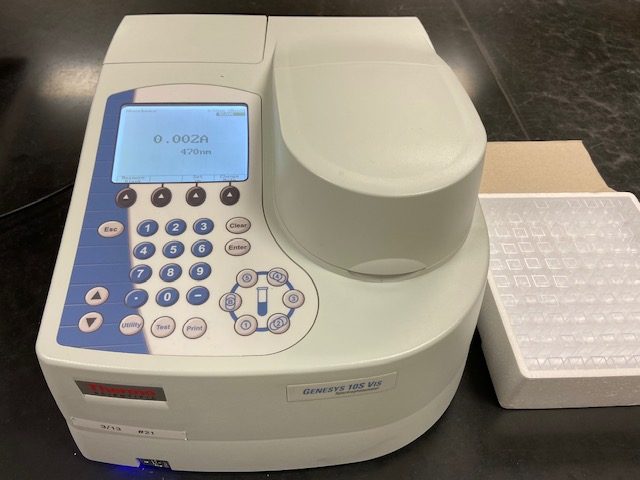
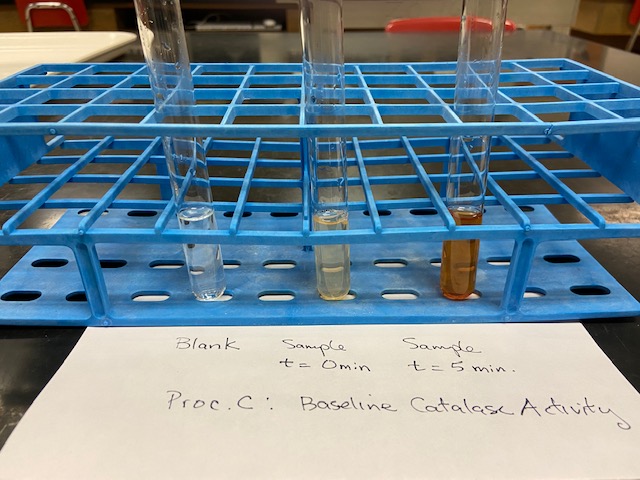
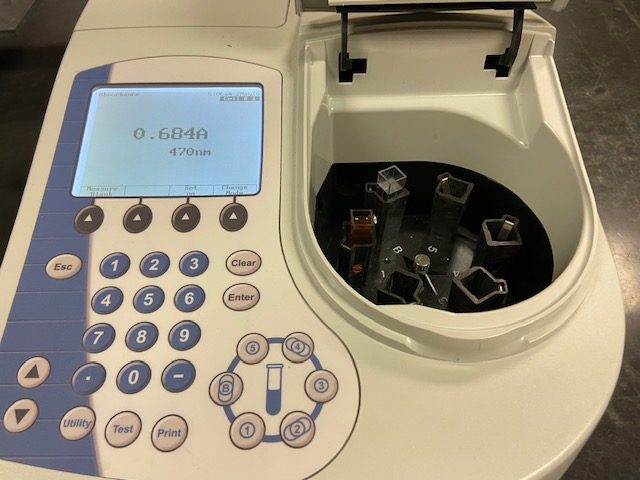
Week 2 of Enzymes
Procedure D Using a Spectrophotometer to Monitor the Activity of Catalase Under Different Environmental Factors.
Since you have already learned about the relative effect of ONE environmental condition on catalase, you will next further explore and quantify the same condition you already studied in Procedure B in Procedure D.
- Groups should write their hypothesis about the effect of their assigned treatment on catalase activity.
- Design their own procedure to quantify their assigned treatment by carrying out 3-4 different additional trial runs.
- Be sure to refer to Hints at the end of Procedure D in your lab handout.
- While the same basic procedure may be followed, what is needed for the blank tube used in the spectrophotometer? Would the blank be the same as Procedure C? Or does it need to change? Why or why not?
Graphing Resources:
Graphing with Excel – Appendix D listed on the Resources page (Appendix Resources for BIO 181 and 183). This lists the 5 key criteria for a proper graph (p. 204) and also shows how to add a trendline and equation for the best fit line (p. 203). These graph additions are both important skills needed for the Enzyme lab assignment and later lab units and Unit assignments in BIO 183 labs.
Understanding and Representing Data – Appendix E listed on the Resources page (Appendix Resources for BIO 181 and 183).
Help for Writing the Different Sections of Lab Reports
- Resources – from the red main menu bar on the lab website. Includes all sorts of information to help you find references, correct reference and citation formats, how to write lab reports….
- Writing the Results and Introduction sections for a lab report (other sections too!)
- LabWrite website
- The Inside-Out Approach to writing a lab report
- Sample Lab Reports – look at formatting AND how references are used and cited !!!
- Lab Report – General Grading Rubric used in BIO 183 (& BIO 181)
*Tips for Writing a Review Paper*(opens in new window) – scroll down to see Choosing a Topic, What to Consider, and Structure of Your Review Paper.
Finding and Citing References in your Lab Report
- NCSU Libraries
- BIO 181 Library Tutorial – you used this in BIO 181 and possibly when looking for Bean Beetle Project references
- CBE/CSE Handout – an updated handout 8th Edition seen below.
- 8th Edition CSE Scientific Style and Format Citation Quick Guide –new link!
- Scroll down to see different types of reference materials: Journals, Books, Websites and Other Online Materials
